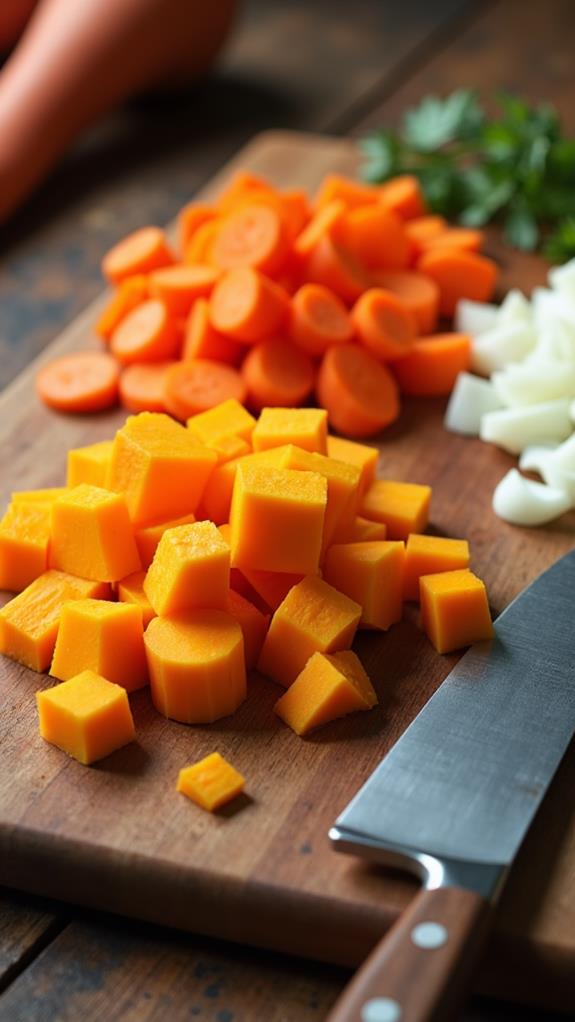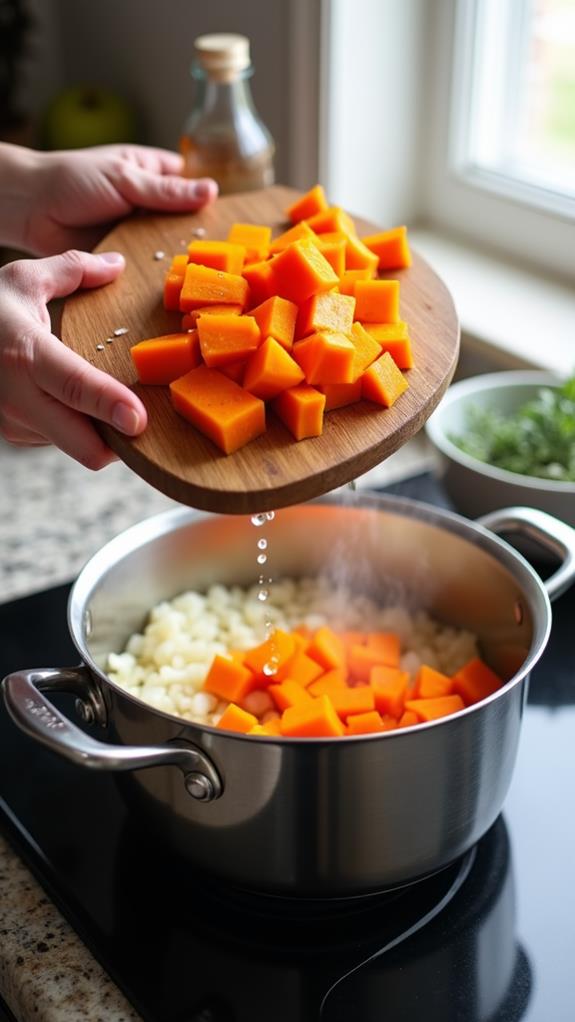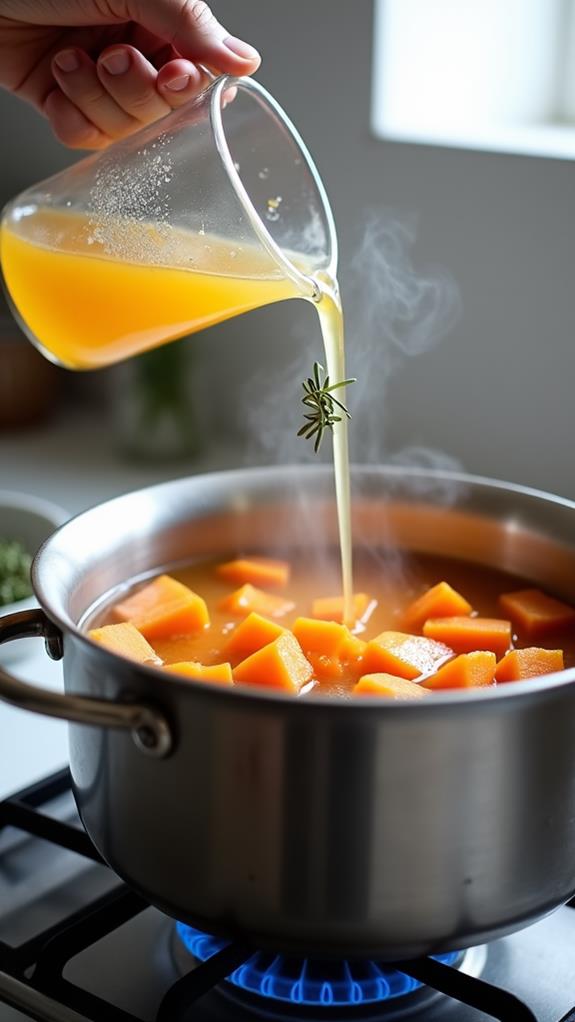Picture yourself at a local farmers' market, surrounded by vibrant autumn produce. You're drawn to a stand offering steaming cups of harvest vegetable soup, its aroma enticing you on this crisp fall day. As you sip the warm, velvety blend, you can't help but wonder about its origins and the perfect balance of flavors. This hearty soup has been a staple of harvest celebrations for generations, bringing comfort and nourishment to communities around the world. But what makes this simple dish so special, and how can you recreate its magic in your own kitchen?
Key Takeaways
- Harvest Vegetable Soup is a hearty blend of seasonal vegetables, typically including squash, carrots, and onions.
- The soup's origins trace back to agrarian societies, evolving through centuries as a popular harvest festival dish.
- Key ingredients include butternut squash, carrots, onions, vegetable broth, and thyme for flavoring.
- Preparation involves sautéing vegetables, simmering in broth, and blending for a smooth, velvety texture.
- The recipe is versatile, allowing for adaptations with different seasonal vegetables and personal taste preferences.
History
Tracing the origins of Harvest Vegetable Soup reveals its deep roots in agrarian societies.
You'll find that this hearty dish has been a staple in farming communities for centuries, evolving as crops and culinary techniques changed over time. The concept of combining seasonal vegetables in a nourishing broth dates back to ancient civilizations, where people made use of whatever produce was available.
In medieval Europe, you'd have seen similar soups prepared in large cauldrons, often serving as a communal meal for entire villages during harvest festivals.
These early versions likely included root vegetables, grains, and herbs that were easily cultivated. As exploration and trade expanded, new ingredients were introduced, diversifying the soup's flavors and textures.
The modern iteration of Harvest Vegetable Soup emerged in the 20th century, coinciding with increased interest in vegetarian diets and health-conscious eating.
You'll notice that today's recipes often feature a blend of traditional and contemporary ingredients, reflecting a fusion of culinary traditions.
This adaptability has ensured the soup's enduring popularity, allowing it to remain a beloved autumn dish across cultures and generations.
Recipe
Harvest Vegetable Soup is a comforting and nutritious dish that celebrates the flavors of autumn. This simple yet delicious soup combines the sweetness of butternut squash with the earthy notes of carrots and the aromatic touch of thyme, all brought together in a warm vegetable broth.
Perfect for chilly evenings, this soup is easy to prepare and can be customized to suit individual tastes. The recipe uses just five key ingredients, making it accessible for cooks of all skill levels while still delivering a flavorful and satisfying meal.
- 1 medium butternut squash, peeled and cubed
- 3 large carrots, peeled and chopped
- 1 large onion, diced
- 6 cups vegetable broth
- 1 teaspoon dried thyme
- Salt and pepper to taste
To prepare the soup, begin by sautéing the diced onion in a large pot over medium heat until translucent. Add the cubed butternut squash and chopped carrots, then pour in the vegetable broth. Sprinkle in the dried thyme and season with salt and pepper.
Bring the mixture to a boil, then reduce heat and simmer for 20-25 minutes, or until the vegetables are tender. Use an immersion blender or transfer the soup to a regular blender and puree until smooth. Taste and adjust seasoning if necessary before serving hot.
For an extra layer of flavor, consider roasting the butternut squash and carrots before adding them to the soup. Toss the cubed vegetables with a little olive oil, salt, and pepper, then roast in a 400°F (200°C) oven for about 25-30 minutes until caramelized.
This step intensifies the natural sweetness of the vegetables and adds depth to the overall taste of the soup. Additionally, feel free to experiment with other seasonal vegetables or herbs to create your own unique variation of this classic autumn dish.
Cooking Steps
To prepare this comforting Harvest Vegetable Soup, you'll start by peeling and chopping the butternut squash, carrots, and onions into bite-sized pieces.
Next, you'll sauté the onions until translucent, then add the squash and carrots, followed by the vegetable broth and dried thyme.
Once the vegetables are tender, you'll blend the soup until smooth, creating a velvety texture that's perfect for a chilly autumn evening.
Step 1. Peel and Chop Vegetables

Begin by gathering your butternut squash, carrots, and onions. These vegetables form the foundation of your Harvest Vegetable Soup, so it's important to prepare them properly.
First, tackle the butternut squash. Use a sharp peeler to remove the tough outer skin, then carefully cut the squash in half lengthwise. Scoop out the seeds and stringy pulp with a spoon, then chop the flesh into bite-sized cubes, about 1-inch in size.
Next, move on to the carrots. Wash them thoroughly, then peel off the outer layer using a vegetable peeler. Trim off the ends and slice the carrots into rounds or half-moons, depending on their thickness.
For the onions, start by cutting off both ends and removing the papery outer skin. Slice the onion in half from top to bottom, then make lengthwise cuts followed by crosswise cuts to create uniform pieces.
Step 2. Sauté Onions Until Translucent

A large pot on the stove marks the start of your Harvest Vegetable Soup journey. Begin by heating the pot over medium heat, then add a splash of oil or a pat of butter. Once the fat is hot, it's time to add your chopped onions.
Spread them evenly across the bottom of the pot, allowing them to come into contact with the heated surface.
Stir the onions occasionally, ensuring they don't stick or burn. As they cook, you'll notice they begin to soften and become translucent. This process usually takes about 5-7 minutes. The onions will release their natural sugars, creating a sweet aroma that fills your kitchen.
You're looking for a soft, slightly golden appearance, but be careful not to brown them too much. If you notice the onions cooking too quickly, reduce the heat slightly.
Once they've reached the desired translucency, you're ready to move on to the next step in your soup-making process.
Step 3. Add Squash and Carrots

Once your onions are translucent, it's time to add the star ingredients of your Harvest Vegetable Soup. Grab your peeled and chopped butternut squash and carrots, and gently add them to the pot. These vibrant vegetables will form the heart of your soup, providing rich flavor and a smooth texture.
As you add the squash and carrots, give the mixture a gentle stir to combine them with the sautéed onions. This step allows the vegetables to mingle and begin sharing their flavors.
Don't worry if the pot seems crowded; the vegetables will soften and reduce as they cook. If you've opted to roast your squash and carrots beforehand, you'll notice they bring an extra depth of sweetness to the mix.
Once all the vegetables are in the pot, take a moment to appreciate the colorful medley you've created. The orange hues of the squash and carrots, combined with the translucent onions, offer a visual preview of the warm, comforting soup to come.
With your main ingredients now in place, you're ready to move on to the next step in creating your delicious Harvest Vegetable Soup.
Step 4. Add Broth and Thyme

With your vegetables now combined in the pot, it's time to add the liquid and seasoning. Pour in the vegetable broth, ensuring it covers all the vegetables. The amount of broth you'll need depends on how thick you prefer your soup, so feel free to adjust accordingly. If you like a thinner consistency, add more broth; for a thicker soup, use less.
Next, sprinkle in the dried thyme. This aromatic herb will infuse your soup with a subtle, earthy flavor that complements the sweetness of the vegetables. Don't be afraid to be generous with the thyme, as its flavor will mellow during cooking. If you're using fresh thyme instead of dried, remember to use about three times as much, as fresh herbs are less potent.
Give the mixture a good stir to distribute the broth and thyme evenly.
At this point, you'll notice the enticing aroma of the herbs and vegetables beginning to meld together. Your Harvest Vegetable Soup is now ready for the final cooking stage, where all these flavors will fully develop and harmonize.
Step 5. Blend Soup Until Smooth

After simmering the vegetables until tender, it's time to transform your mixture into a velvety smooth soup. You'll need to blend the ingredients thoroughly to achieve the desired consistency.
If you have an immersion blender, you're in luck. Simply insert it directly into the pot and blend until smooth, moving it around to ensure all chunks are pureed. This method is quick, easy, and minimizes cleanup.
If you don't have an immersion blender, don't worry. You can use a regular blender or food processor instead. However, you'll need to work in batches. Carefully ladle portions of the hot soup into your blender, filling it no more than halfway. Secure the lid tightly, placing a kitchen towel over it for added safety. Blend each batch until smooth, then transfer to a clean pot or bowl.
Repeat this process until all the soup is pureed.
Once blended, give your soup a taste. If it's too thick, you can thin it out with a bit more broth. If it's too thin, simmer it for a few more minutes to reduce and thicken.
Final Thoughts
This Harvest Vegetable Soup recipe offers a delicious and straightforward way to enjoy autumn's bounty.
You'll find that it's not only easy to prepare but also versatile, allowing you to adapt it to your preferences.
Don't hesitate to experiment with different seasonal vegetables or herbs to create your own unique version.
If you're looking to enhance the flavor profile, consider roasting the butternut squash and carrots before adding them to the soup.
This extra step will caramelize their natural sugars, intensifying the overall taste.














